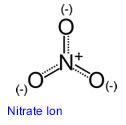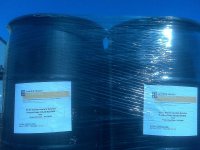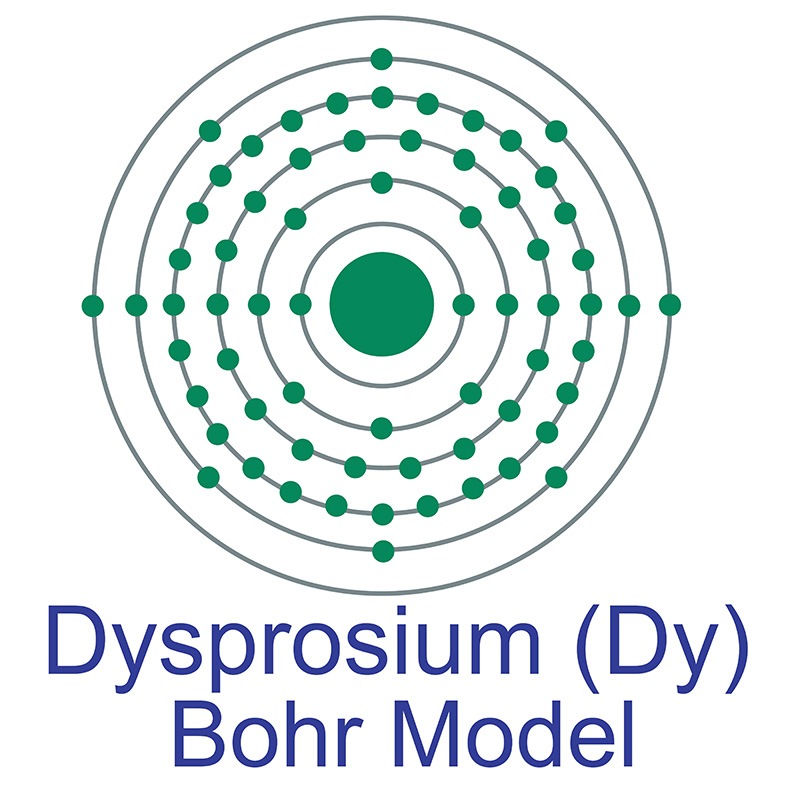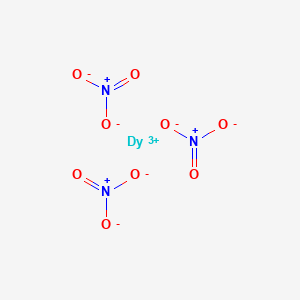SECTION 1. IDENTIFICATION
Product Name: Dysprosium Nitrate Solution
Product Number: All applicable American Elements product codes, e.g. DY-NAT-02-SOL
, DY-NAT-03-SOL
, DY-NAT-04-SOL
, DY-NAT-05-SOL
CAS #: 10143-38-1
Relevant identified uses of the substance: Scientific research and development
Supplier details:
American Elements
10884 Weyburn Ave.
Los Angeles, CA 90024
Tel: +1 310-208-0551
Fax: +1 310-208-0351
Emergency telephone number:
Domestic, North America: +1 800-424-9300
International: +1 703-527-3887
SECTION 2. HAZARDS IDENTIFICATION
Classification
Physical Hazard: Not classified.
Health Hazard: Skin Corrosion/Irritation Category 1B
Serious Eye Damage/Eye Irritation Category 1
Label Elements

Symbol
Signal Word
DANGER
Hazard Statement(s)
H314 Causes severe skin burns and eye damage.
Precautionary Statement(s)
P260 Do not breathe fumes, mists, vapors, or spray.
P264 Wash hands thoroughly after handling.
P280 Wear protective gloves, protective clothing, and eye protection.
P301+P330+P331 If swallowed: Rinse mouth. Do NOT induce vomiting.
P303+P361+P353 If on skin (or hair): Remove immediately all contaminated clothing. Rinse skin with water.
P304+P340 If inhaled: Remove person to fresh air and keep comfortable for breathing.
P305+P351+P338 If in eyes: Rinse cautiously with water for several minutes. Remove contact lenses, if present and easy to do. Continue rinsing.
P310 Immediately call a doctor.
P363 Wash contaminated clothing before reuse.
P405 Store locked up.
P501 Dispose of contents and container according to local regulations.
Hazards Not Otherwise Classified: N/A.
Ingredients(s) with Unknown Acute Toxicity: N/A.
SECTION 3. COMPOSITION/INFORMATION ON INGREDIENTS
Substance: Dysprosium in nitric acid solution
Other Designations: Nitric acid (aqua fortis; hydrogen nitrate; azotic acid; engraver’s acid)
Dysprosium nitrate [Dysprosium trinitrate; Nitric acid, dysprosium (3+) salt (3:1)]
NOTE: Dysprosium in nitric acid solution forms a solvated dysprosium nitrate salt. The health and physical hazard information provided in this SDS are for nitric acid and dysprosium nitrate, a rare earth salt. No physical or chemical data are listed for this solution. The actual effects of the solution may differ from the individual components.
Components are listed in compliance with OSHA’s 29 CFR 1910.1200; for the actual values see the NIST Certificate of Analysis.
Hazardous Component(s)
CAS Number
EC Number
(EINECS)
Nominal Mass Concentration
(%)
Nitric acid
7697-37-2
231-714-2
10
Dysprosium nitrate
10143-38-1
233-410-5
2.1
Non-Hazardous Component(s)
Water
7732-18-5
231-791-2
>87
SECTION 4. FIRST AID MEASURES
Description of First Aid Measures:
Inhalation: If adverse effects occur, remove to uncontaminated area. If not breathing, give artificial respiration or oxygen by qualified personnel. Seek immediate medical attention.
Skin Contact: Wash skin with soap and water for at least 15 minutes while removing contaminated clothing and shoes. Get immediate medical attention. Thoroughly clean and dry contaminated clothing before reuse. Destroy contaminated shoes.
Eye Contact: Immediately flush eyes, including under the eyelids with copious amounts of water for at least 15 minutes. Seek immediate medical attention.
Ingestion: Contact a poison control center immediately for instructions. Do not induce vomiting. Give water to rinse out mouth. Never give liquids to a person with reduced awareness or becoming unconscious. If vomiting occurs, keep head lower than hips to prevent aspiration. If not breathing, give artificial respiration by qualified personnel. Seek immediate medical attention.
Most Important Symptoms/Effects, Acute and Delayed: Acid burns to skin, eyes, and lungs.
Indication of any immediate medical attention and special treatment needed, if necessary: If any of the above symptoms are present, seek immediate medical attention.
SECTION 5. FIREFIGHTING MEASURES
Fire and Explosion Hazards: Negligible fire hazard. See Section 9, “Physical and Chemical Properties” for flammability properties.
Extinguishing Media:
Suitable: Use extinguishing media appropriate to the surrounding fire.
Unsuitable: None listed.
Specific Hazards Arising from the Chemical: Miscellaneous decomposition products.
Special Protective Equipment and Precautions for Fire-Fighters: Avoid inhalation of material or combustion byproducts. Wear full protective clothing and NIOSH approved self-contained breathing apparatus (SCBA).
NFPA Ratings (0 = Minimal; 1 = Slight; 2 = Moderate; 3 = Serious; 4 = Severe)
Health = 3 Fire = 0 Reactivity= 0
SECTION 6. ACCIDENTAL RELEASE MEASURES
Personal Precautions, Protective Equipment and Emergency Procedures: Immediately contact emergency personnel. Keep unnecessary personnel away. Use suitable protective equipment; see Section 8, “Exposure Controls and Personal Protection”.
Methods and Materials for Containment and Clean up: Do not touch spilled material. Notify safety personnel of spills. Absorb with sand or other non-combustible material. Collect spilled material in appropriate container for disposal. Isolate hazard area and deny entry.
SECTION 7. HANDLING AND STORAGE
Safe Handling Precautions: See Section 8, “Exposure Controls and Personal Protection”. Handle glass ampoules with care.
Storage: Store and handle in accordance with all current regulations and standards. Keep separated from incompatible substances (see Section 10, “Stability and Reactivity”).
SECTION 8. EXPOSURE CONTROLS/PERSONAL PROTECTION
Exposure Limits
Component(s)
OSHA (PEL)
ACGIH (TLV)
NIOSH (REL)
Nitric acid
5 mg/m3 (2 ppm) TWA
5 mg/m3 (2 ppm) TWA 10 mg/m3 (4 ppm) STEL
5 mg/m3 (2 ppm) TWA 10 mg/m3 (4 ppm) STEL 65 mg/m3 (25 ppm) IDLH
Dysprosium nitrate
No occupational limits established.
Engineering Controls: Provide local exhaust or process enclosure ventilation system. Ensure compliance with applicable exposure limits.
Personal Protection: In accordance with OSHA 29 CFR 1910.132, subpart I, wear appropriate Personal Protective Equipment (PPE) to minimize exposure to this material.
Respiratory Protection: If workplace conditions warrant a respirator, a respiratory protection program that meets OSHA29CFR 1910.134 must be followed. Refer to NIOSH 42 CFR 84 for applicable certified respirators.
Eye/Face Protection: Wear splash resistant safety goggles with a face shield. An eyewash station should be readily available near areas of use.
Skin and Body Protection: Personal protective equipment for the body should be selected based on the task being performed and the risks involved and should be approved by a specialist before handling this product. Chemical-resistant gloves should be worn at all times when handling chemicals.
SECTION 9. PHYSICAL AND CHEMICAL PROPERTIES
NOTE: The physical and chemical data provided are for the pure components.
Descriptive Properties
Nitric acid (10 % of this SRM)
Dysprosium nitrate (2.1 % of this SRM)
Appearance (physical state, color, etc.)
colorless to yellow liquid
white to pale yellow crystals
Molecular Formula
HNO3
Dy(NO3)3
Molar Mass (g/mol)
63.01
348.51
Odor
irritating odor
not available
Odor threshold (mg/m3)
not available
not available
pH
1 (1 M)
not available
Evaporation rate
not available
not applicable
Melting point/freezing point
–42 ºC (–43 ºF)
not available
Relative Density as specific gravity (water = 1)
1.5027 at 25 ºC
not available
Vapor Pressure (mmHg)
47.9 at 20 ºC
not available
Vapor Density (air = 1)
3.2
not available
Viscosity
not available
not available
Solubility(ies)
miscible with water and ether
miscible in water
Partition coefficient (n-octanol/water)
not available
not available
Thermal Stability Properties
Autoignition Temperature
not applicable
not available
Thermal Decomposition
not applicable
not available
Initial boiling point and boiling range
83 ºC (181 ºF)
not available
Explosive Limits, LEL (Volume %)
not applicable
not available
Explosive Limits, UEL (Volume %)
not applicable
not available
Flash Point
not applicable
not available
Flammability (solid, gas)
not applicable
not available
SECTION 10. STABILITY AND REACTIVITY
Reactivity: Stable at normal temperatures and pressure.
Stability:
X
Stable
Unstable
Possible Hazardous Reactions: None listed.
Conditions to Avoid: Contact with combustible or incompatible materials.
Incompatible Materials: Acids, combustible materials, halo carbons, amines, bases, oxidizing materials, metals, halogens, metal salts, metal oxides, reducing agents, peroxides, metal carbide, cyanides.
Fire/Explosion Information: See Section 5, “Fire Fighting Measures”.
Hazardous Decomposition: Thermal decomposition will produce oxides of nitrogen, dysprosium, and other miscellaneous decomposition products.
Hazardous Polymerization:
Will Occur
X
Will Not Occur
SECTION 11. TOXICOLOGICAL INFORMATION
Route of Exposure:
X
Inhalation
X
Skin
X
Ingestion
Symptoms Related to the Physical, Chemical and Toxicological Characteristics: Acid burns to skin, eyes, and lungs.
Potential Health Effects (Acute, Chronic and Delayed):
Inhalation: Inhalation of acid fumes can damage the mucous membranes and upper respiratory tract. Short term exposure may cause irritation and inflammation of the upper respiratory tract, coughing, choking, sore throat, shortness of breath, headache, dizziness, and nausea. Long term exposure to acid fumes may cause damage to teeth, bronchial irritation, chronic cough, bronchial pneumonia, and gastrointestinal disturbances.
Skin Contact: Nitric acid can cause severe skin burns. Severity of the damage depends on the concentration and duration of exposure. Effects of acid burns may be delayed.
Eye Contact: Nitric acid can cause severe eye irritation, corneal burns, permanent eye damage, or blindness. Severity of the damage depends on the concentration and duration of exposure.
Ingestion: If ingested, nitric acid can cause severe burns and damage to the gastrointestinal tract.
Numerical Measures of Toxicity
Acute Toxicity: Not classified.
Nitric acid: Rat, Inhalation LC50: 130 mg/m3 (4 h)
Dysprosium nitrate:Rat, Oral LD50: 2386 mg/kg
Skin Corrosion/Irritation: This SRM contains >1 % of nitric acid and it is classified as Category 1B.
Serious Eye Damage/Eye Irritation: This SRM contains >1 % nitric acid and it is classified as Category 1.
Respiratory Sensitization: No data available.
Skin Sensitization: No data available.
Germ Cell Mutagenicity: No data available.
Carcinogenicity: Not classified.
Listed as a Carcinogen/Potential Carcinogen
Yes
X
No
Nitric acid and dysprosium nitrate are not listed by NTP, IARC or OSHA as carcinogens/potential carcinogens.
Reproductive Toxicity: Not classified.
Nitric acid: Rat, Oral TDLo: 21 150 mg/kg (pregnant 1 d to 21 d)
Rat, Oral TDLo: 2345 mg/kg (pregnant 18 d)
Specific Target Organ Toxicity, Single Exposure: No data available.
Specific Target Organ Toxicity, Repeated Exposure: No data available.
Aspiration Hazard: No data available.
SECTION 12. ECOLOGICAL INFORMATION
Ecotoxicity Data
Nitric acid: Fish, hooknose or pogge (Agonus cataphractus) LC50: 100 mg/L to 330 mg/L (48 h)
Dysprosium nitrate: No data available.
Persistence and Degradability: No data available.
Bioaccumulative Potential: No data available.
Mobility in Soil: No data available.
Other Adverse effects: No data available.
SECTION 13. DISPOSAL CONSIDERATIONS
Waste Disposal: Dispose of waste in accordance with all applicable federal, state, and local regulations. Subject to disposal regulations: U.S. EPA 40 CFR 262, Hazardous Waste Numbers: nitric acid (D001, D002).
SECTION 14. TRANSPORT INFORMATION
U.S. DOT and IATA: UN1760, Corrosive liquid, n.o.s. (contains nitric acid), Hazard Class 8, Packing Group II, Excepted Qty: E2.
SECTION 15. REGULATORY INFORMATION
U.S. Regulations:
CERCLA Sections 102a/103 (40 CFR 302.4): Nitric acid, 1000 lbs. (454 kg) final RQ
SARA Title III Section 302 (40 CFR 355.30): Nitric acid, 1000 lbs. (454 kg) TPQ
SARA Title III Section 304 (40 CFR 355.40): Nitric acid, 1000 lbs. (454 kg) EPCRA RQ
SARA Title III Section 313 (40 CFR 372.65): 1 % de minimis concentration for nitric acid.
OSHA Process Safety (29 CFR 1910.119): Regulated for nitric acid at higher concentrations 500 lbs. TQ (≥94.5 % by weight).
SARA Title III Sections 311/312 Hazardous Categories (40 CFR 370.21):
ACUTE HEALTH: Yes
CHRONIC HEALTH: No
FIRE: No
REACTIVE: No
PRESSURE: No
State Regulations: Not listed under California Proposition 65.
U.S. TSCA Inventory: Nitric acid is listed. Dysprosium nitrate is not listed.
TSCA 12(b), Export Notification: Not listed.
Canadian Regulations: WHMIS Information is not provided for this material.
SECTION 16. OTHER INFORMATION
Safety Data Sheet according to Regulation (EC) No. 1907/2006 (REACH). The above information is believed to be correct but does not purport to be all inclusive and shall be used only as a guide. The information in this document is based on the present state of our knowledge and is applicable to the product with regard to appropriate safety precautions. It does not represent any guarantee of the properties of the product. American Elements shall not be held liable for any damage resulting from handling or from contact with the above product. See reverse side of invoice or packing slip for additional terms and conditions of sale. COPYRIGHT 1997-2022 AMERICAN ELEMENTS. LICENSED GRANTED TO MAKE UNLIMITED PAPER COPIES FOR INTERNAL USE ONLY.

 materials. American Elements can prepare dissolved homogeneous solutions at customer specified concentrations or to the maximum stoichiometric concentration. Packaging is available in 55 gallon drums, smaller units and larger liquid totes. American Elements maintains
materials. American Elements can prepare dissolved homogeneous solutions at customer specified concentrations or to the maximum stoichiometric concentration. Packaging is available in 55 gallon drums, smaller units and larger liquid totes. American Elements maintains  The number of electrons in each of dysprosium's shells is [2, 8, 18, 28, 8, 2] and its electron configuration is [Xe]4f10 6s2. The dysprosium atom has an atomic radius of 178 pm and a Van der Waals radius of 229 pm. Dysprosium was first discovered by Paul Emile Lecoq de Boisbaudran in 1886. In its elemental form, dysprosium has a silvery-white appearance.
The number of electrons in each of dysprosium's shells is [2, 8, 18, 28, 8, 2] and its electron configuration is [Xe]4f10 6s2. The dysprosium atom has an atomic radius of 178 pm and a Van der Waals radius of 229 pm. Dysprosium was first discovered by Paul Emile Lecoq de Boisbaudran in 1886. In its elemental form, dysprosium has a silvery-white appearance.  It is a member of the lanthanide or
It is a member of the lanthanide or 
